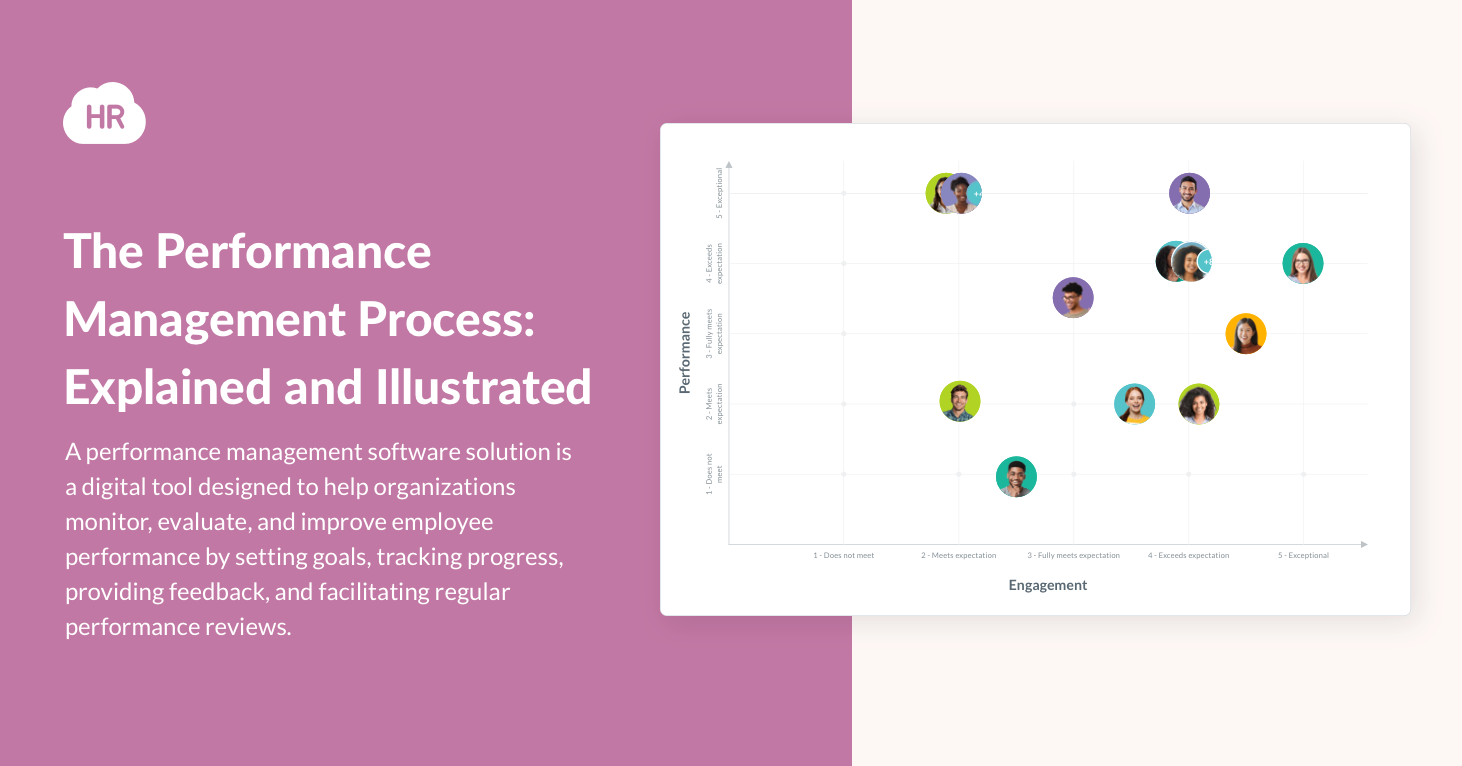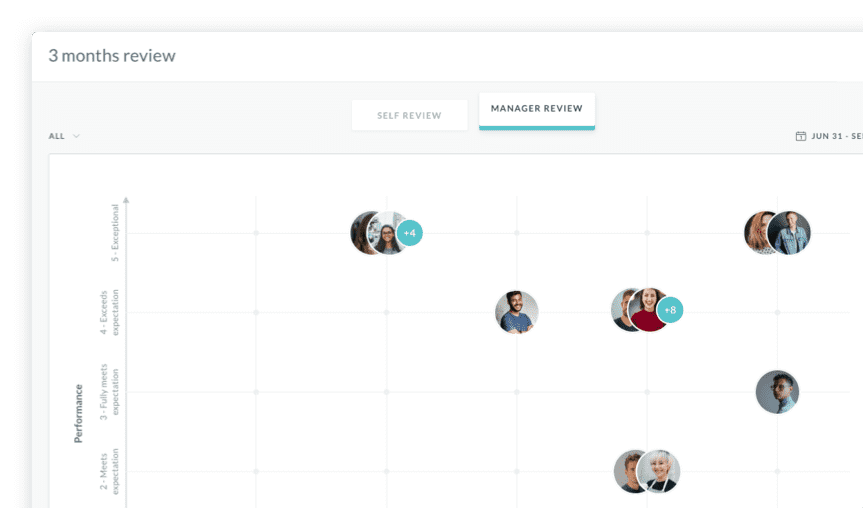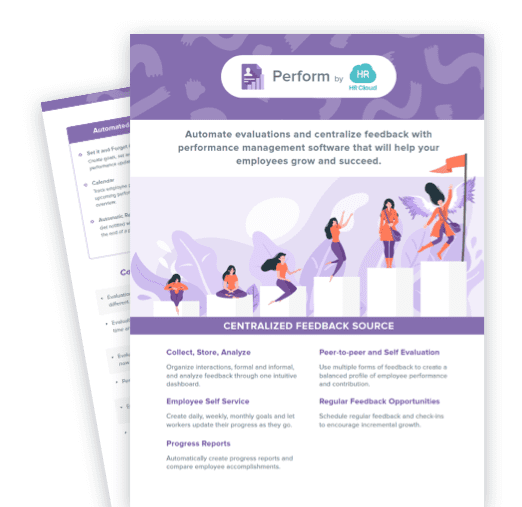The Performance Management Process: Explained and Illustrated



 Cut onboarding time
by 60%—here's the
Ultimate Checklist
that helped do it.
Cut onboarding time
by 60%—here's the
Ultimate Checklist
that helped do it.

A performance management software solution is a digital tool designed to help organizations monitor, evaluate, and improve employee performance by setting goals, tracking progress, providing feedback, and facilitating regular performance reviews.
It streamlines the performance management process, especially if companies are still using outdated, manual approaches. The right solution also enhances transparency and supports data-driven decision-making to align employee objectives with overall business goals.
The key objectives of a performance management solution and approach are to align individual employee goals with the organization’s strategic objectives and enhance team productivity through continuous feedback and development. Performance management can also foster a culture of accountability and engagement by ensuring clear communication of expectations and recognition of achievements.
But to fully understand what a performance management solution is and how it can help companies achieve better business results, here is a detailed explanation (with examples) of how the ideal performance management process works.
Overview of the Performance Management Process
To effectively manage and enhance employee performance, it’s important to understand the key stages involved in the performance management process.
1. Setting Performance Expectations
To achieve optimal performance outcomes, establishing clear and actionable performance expectations is essential.
-
The role of job descriptions: Clearly define roles and responsibilities through detailed job descriptions to ensure employees understand their primary duties and how their work contributes to organizational objectives.
-
Establishing SMART goals: Set Specific, Measurable, Achievable, Relevant, and Time-bound (SMART) goals to provide clear and actionable performance targets that align with both individual and organizational priorities.
-
Engaging employees in goal setting: Involve employees in the goal-setting process to increase ownership, motivation, and alignment with the company’s strategic objectives, fostering a collaborative and committed work environment.
2. Continuous Monitoring and Feedback
To ensure ongoing improvement and engagement, it's crucial to implement strategies for continuous monitoring and feedback.
-
Methods of performance management: Utilize various performance management methods such as 360-degree feedback, peer reviews, and self-assessments to gain a comprehensive view of employee performance.
-
The importance of regular feedback: Provide consistent and timely feedback to help employees adjust their efforts, recognize accomplishments, and stay aligned with organizational goals, leading to continuous improvement and growth.
-
Tools for tracking performance: Implement tools like performance dashboards, KPI tracking software, and employee progress reports to monitor performance in real-time and make data-driven decisions.
3. Performance Evaluations
Types of performance appraisals include:
-
Self-appraisal: Employees assess their own performance against set objectives.
-
Peer review: Colleagues evaluate each other’s performance, often anonymously.
-
360-degree feedback: Combines feedback from supervisors, peers, subordinates, and sometimes clients to provide a comprehensive evaluation.
Criteria for evaluation include:
-
Goal achievement: Assessment based on whether employees meet or exceed specific targets.
-
Job knowledge and skills: Evaluation of the employee’s technical proficiency and expertise in their role.
-
Behavioral competencies: Measurement of interpersonal skills, teamwork, adaptability, and communication.
Common pitfalls to avoid:
-
Bias: Allowing personal feelings or stereotypes to influence the evaluation.
-
Halo effect: Overemphasizing one positive aspect of an employee’s performance, leading to an overall higher rating.
-
Lack of specificity: Providing vague or general feedback that doesn’t help employees improve or understand their performance.

The Need for Communication in Performance Management
Effective communication in performance management is essential for ensuring that employees understand expectations, receive constructive feedback, and are aligned with organizational goals. It fosters a transparent environment where both managers and employees can discuss progress, address challenges, and collaboratively work toward improvement.
1. Techniques for Effective Communication
To ensure effective communication within a team, it’s important to implement a variety of techniques that include personalized one-on-one meetings, collaborative team feedback sessions, and the use of digital tools for clear and consistent messaging.
-
One-on-one meetings: Regular, private meetings between managers and employees to discuss performance, set goals, and address any concerns or feedback in a personalized manner.
-
Team feedback sessions: Group discussions that encourage open dialogue, collective problem-solving, and the sharing of insights to enhance team performance and collaboration.
-
Digital communication tools: Utilizing platforms like email, instant messaging, and project management software to facilitate timely and clear communication, track progress, and maintain records of feedback and objectives.
2. Fostering a Feedback Culture
To create a thriving feedback culture, it's crucial to implement strategies that encourage open communication, equip employees with the skills for giving and receiving feedback, and recognize achievements to inspire ongoing success.
-
Encouraging open dialogue: Promote an environment where employees feel safe to voice opinions, ask questions, and provide feedback without fear of judgment or retribution.
-
Training for effective feedback: Provide training to both managers and employees on how to give and receive constructive feedback that is specific, actionable, and focused on growth.
-
Celebrating successes: Regularly acknowledge and celebrate achievements, both big and small, to reinforce positive behaviors and motivate continued excellence.
3. Organizational Support for Growth
To support employee growth and development, organizations should provide a variety of resources and opportunities that cater to both professional and personal advancement.
-
Training and development programs: Offer structured learning opportunities, such as workshops, seminars, and online courses, to help employees enhance their skills and advance their careers.
-
Mentoring opportunities: Establish mentorship programs that pair employees with experienced professionals who can provide guidance, share knowledge, and support personal and professional growth.
-
Resources for personal development: Provide access to tools, books, wellness programs, and other resources that encourage continuous learning and holistic development outside of formal training.

If you want to learn more about
the possibilities of Perform, click here!
The Impact of Performance Management
Effective performance management plays a critical role in enhancing employee engagement by providing clear expectations, regular feedback, and opportunities for growth. When an effective performance cycle is implemented, employees feel supported and understand how their contributions matter. They are more motivated and committed to their work, leading to higher productivity and job satisfaction.
By aligning employees’ goals with the organization's objectives, performance management ensures that everyone is working towards the same outcomes. This alignment fosters a sense of purpose and unity within the company, driving collective success. When employees understand how their individual goals contribute to broader company goals, they are more likely to be invested in achieving them.
Measuring the return on investment (ROI) of performance management is essential for understanding its impact on the company’s success. A well-implemented performance management system can reduce employee turnover, improve employee performance, and improve overall business results. By tracking these outcomes, companies can quantify the value of their investment in performance management and continually refine their strategies for maximum effectiveness.
Summary and Conclusion
Performance management is a vital tool for fostering a productive and engaged workforce. By implementing regular feedback, aligning individual and organizational goals, and providing opportunities for growth, companies can significantly enhance employee performance and satisfaction. Key points include the importance of open communication, the need for clear and measurable objectives, and the value of recognizing and rewarding success. These elements not only drive individual growth but also contribute to the overall success of the organization.
Looking ahead, the future of performance management is likely to be shaped by continued advancements in technology and an increasing focus on employee well-being. Digital tools will play a larger role in facilitating real-time feedback and tracking progress, making the process more dynamic and personalized. As organizations place greater emphasis on creating supportive environments, performance management will evolve to incorporate more holistic approaches, blending professional development with personal growth to ensure a more engaged and motivated workforce.
Author Bio:
This article is written by a marketing team member at HR Cloud. HR Cloud is a leading provider of proven HR solutions, including recruiting, onboarding, employee communications & engagement, and rewards & recognition. Our user-friendly software increases employee productivity, delivers time and cost savings, and minimizes compliance risk.
Keep Reading
The Hidden Metrics of Frontline Success: Beyond Engagement Scores
"What gets measured gets managed, but what gets measured well gets transformed." — Peter
Embracing Diversity: Recognizing Different Cultures in the Workplace
Workplaces today reflect the incredible diversity of the world around us. People bring
From Manual to Automated: A Complete Guide to Digitizing Employee Onboarding for Large Organizations
Sarah Chen, Director of HR at a 7,000-employee healthcare organization, starts her Monday
Like What You Hear?
We'd love to chat with you more about how HR Cloud® can support your business's HR needs. Book Your Free Demo

Build a Culture of Recognition. Boost Engagement. Guaranteed.
Workmates empowers employees to stay informed, connected, and appreciated—whether they’re on the front line, in the office, or remote. Recognition drives 12x higher engagement.Trusted by industry leaders in every sector




Cut Onboarding Costs by 60%.
Take the confusion and follow-ups out of onboarding with automated workflows, digital forms, and structured portals—so new hires ramp faster 3X quicker.Trusted by industry leaders in every sector




